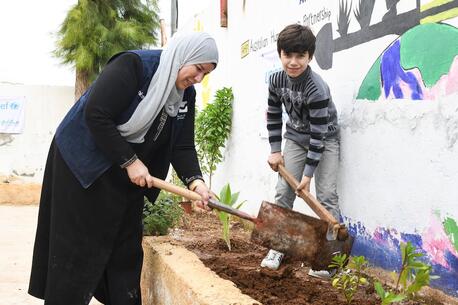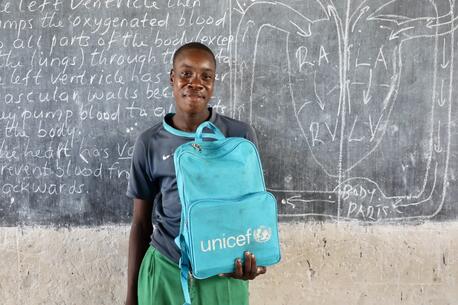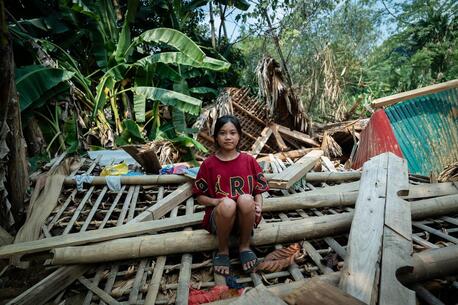
How to Talk to Children About Climate Change
Climate change is an incredibly important topic for everyone who calls the Earth their home. This issue already has or will affect every child in the world. Whether you are a parent, caregiver, educator or counselor, you may feel apprehensive talking to children about climate change. Read on for some assistance on how to start the conversation, important topics to cover and how to keep climate change top of mind.
Practical tips for parents, caregivers, educators
Climate change, or global warming, can be a complicated topic for adults to understand. So you may be wondering: How can I discuss it with the children in my life, and do I need to?
Climate change will affect every child in the world at some point in their lifetime. While you may think avoiding the subject protects them from worry or anxiety, it's likely already on their radar.
They're probably already hearing it mentioned at school, online and among friends. It could be part of a storyline in a favorite television show. They may be feeling mixed emotions, all of which are valid.
If children are confused, angry, sad or fearful, adults can provide some reassurance. Whether you are a parent, caregiver, educator or counselor, you can help children learn the facts, understand that they’re not alone and inspire ways to take action.

Here are some tips to prepare for and conduct honest and meaningful conversations with children about climate change.
1. Do your research
Take some time to explore the many reliable online resources about climate change before starting a conversation.
Many reputable organizations, like National Geographic Kids, have done the homework for you already. Their child-friendly resources can assist you in brushing up on the science of climate change. NASA also has a great collection of information worth exploring with children.
If you’re an educator, the United States Environmental Protection Agency (EPA) offers resources to help plan classroom lessons.
Doing some research beforehand will help you start the conversation. A question you can't answer is an opportunity to learn together.
2. Break it down
Once you’ve done your own research on climate change and reviewed child-friendly resources, take some time to think about the children in your life. What do you think will resonate most?
A great place to start is by relating climate change to children's daily lives and breaking down the science into simple, age-appropriate language.
For example: you might discuss how fossil fuels are used in your home, school and modes of transportation; that the burning of those fuels leads to an increase of greenhouse gasses in the atmosphere; and that those gasses insulate the planet, in the same way that the walls of your home keep the warmth in, creating a hotter Earth. Rising temperatures can have many effects, ranging from increased floods and storms to melting polar ice caps and rising sea levels.
Visual aids like pictures and videos may help make this complicated subject more digestible. Climate Visuals offers a collection of images showcasing climate impacts and solutions. There are videos available on YouTube that break things down; just be sure the sources are credible. This NASA Climate Kids playlist is a great place to start.

3. Actively listen
Consider kicking off the conversation by asking children what they already know about climate change. Have they heard the subject mentioned before? Where did they hear about it and how did it make them feel?
Their answers may surprise you. Just be sure that when they are sharing their knowledge and emotions with you, you stay focused. Put your phone down, limit any distractions and provide your undivided attention. Actively listen by asking questions and mirroring their language so that they feel heard and understood.
Although you may instinctively want to assuage their fears about the future of the planet, be sure not to dismiss or minimize any worries they have.
4. Spend time outside
Exposing children to the wonders of nature is a great way to grow their appreciation for the planet.
Encourage kids to spend time outside doing things they love. You know them best; perhaps they’ll enjoy riding their bikes through the park, surveying trees and looking for birds or going on a camping trip. Spend time watching the clouds and talking about how weather changes can occur. Observe trees, plants and flowers and explain how the Earth and our atmosphere nurture living things.
Cultivating an understanding and love of the natural world around us will help children understand the importance of taking action to prevent and mitigate climate change.
5. Look for the helpers
“When I was a boy and I would see scary things in the news, my mother would say to me, ‘Look for the helpers. You will always find people who are helping.’” — Mister Rogers
With a topic as uncertain and overwhelming as climate change, children may start to feel a sense of dread or hopelessness. This is when you should be ready with examples of the helpers: people who are working tirelessly on ways to effectively address climate change.
UNICEF believes in backing young innovators to accelerate climate action. Young UNICEF climate activists are focused on leaving the planet better than they found it, leaning into optimism and determination to make it happen, and demanding action from governments.
These are just a few examples. See if you can find positive and inspiring stories about climate action close to home that you can share with the children in your life.
6. Inspire action
Learning and understanding are the first steps to taking action. Be sure to talk through the different levels of engagement, and ensure that children don’t feel like the enormous issue of climate change is falling squarely on their shoulders.
Start small by discussing what steps you can take, or are already taking, in your home or school to address climate change. Perhaps you can reduce waste in your home by saving water, recycling more effectively or unplugging unused lights and appliances. Could you add solar panels to your roof, carpool or ride a bike to work or school, or plant a few trees in your community?
Every action is important in the fight against climate change.
If the child or children you’re talking to are interested in taking a larger role in the climate movement, be open to their ideas and aspirations. Look through these tools for young climate activists with them, and help them create a plan to get started.

While the subject of climate change may be challenging, it's important to keep it top of mind. Ongoing conversation is critical around an issue that is shaping the future of our planet and impacting every living thing — the world's children most of all.
Related: How to Talk to Children About Conflict and War
HOW TO HELP
There are many ways to make a difference
War, famine, poverty, natural disasters — threats to the world's children keep coming. But UNICEF won't stop working to keep children healthy and safe.
UNICEF works in over 190 countries and territories — more places than any other children's organization. UNICEF has the world's largest humanitarian warehouse and, when disaster strikes, can get supplies almost anywhere within 72 hours. Constantly innovating, always advocating for a better world for children, UNICEF works to ensure that every child can grow up healthy, educated, protected and respected.
Would you like to help give all children the opportunity to reach their full potential? There are many ways to get involved.




